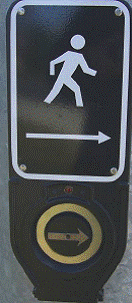
Push button integrated Accessible Pedestrian Signals (APS).
According to the June 25th edition of the U.S, Access Board’s Access Currents, “Product innovations and improved technologies have enhanced the accessibility of pedestrian signals now on the market. Low-volume audible signals and tactile features have been incorporated into the design of products to provide access to pedestrians with vision impairments more effectively. The industry standard, the Manual on Uniform Traffic Control Devices, includes specifications for accessible pedestrian signals which derive from recommendations developed by a former Board advisory panel, the Public Rights-of-Way Access Advisory Committee.
“The Board has released new guidance on installing these types of pedestrian signals. ‘Common Problems Arising in the Installation of Accessible Pedestrian Signals’ reviews access features of available products, including locator tones, audible and vibrotactile indicators of crossing cycles, and signal volume and explains important considerations in the placement and orientation of signal devices. The low-volume indicators of current products make proper installation essential in order for signals to be effective. The bulletin uses case studies and field evaluations to illustrate various installation ‘do’s and don’ts’ in relation to common site conditions and factors.”
The publication, which includes an installation checklist and other resources on accessible public rights-of-way are available on the Board’s website at:
http://tinyurl.com/ncogn4













No comments yet
Comments feed for this article